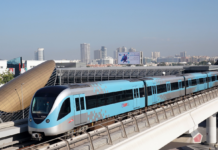Source: www.ameinfo.com
DTZ, the international real estate advisory firm, today released a report analysing the potential impact of the Dubai Metro on land and property prices.

Martin Cooper, Head of Consulting for DTZ Middle East, said:
“The main objective for developing this report was to cut through the raft of anecdotal commentary that has recently appeared in the press. We have used our extensive experience advising on infrastructure and real estate projects throughout the world, along with other numerous international case studies, to develop this report. We believe it will serve as a key point of reference as to the likely impact of the Dubai Metro on the Emirate’s real estate market.”
The report highlights the following key findings:
Accessibility
This is the most significant determining factor of property value uplift. DTZ’s report highlights areas around two stations in Dubai, Jumeirah Lake Towers (JLT) and Dubai International Financial Centre (DIFC). One area is within 400 metres walking distance of each station and the other is within 800 meters. The biggest uplifts will be experienced in the 400 metre zone as it is broadly tied in with the distance people are willing to walk – which is concurrent with international case studies. However, in the case of Dubai, the acceptable walking distances will be at the lower end of the spectrum because of the prevailing weather conditions. Proactive action can be taken to extend the catchment area by providing covered walkways (an initiative the RTA is already implementing).
Magnitude of uplift
The higher the usage rates of the Metro, the higher the value uplifts. This reinforces the notion that transit accessibility is the strongest determinant of property value uplift.
Another impact on the magnitude of uplift is how accessible the area was before the opening of the Metro. In Dubai’s case, there was very little public transport to speak of, so the accessibility ratio for land and property along the Metro line will have increased significantly, thus having a greater impact on values.
However, the report suggests there are other factors which can impact the value uplift. The current state of the market is a major factor – if the market is in a downturn, the degree of accessibility is irrelevant as prices are still likely to decrease.
Location
Evidence suggests that Central Business District (CBD) locations are less likely to benefit from large uplifts. The reason for this is that CBD locations are already accessible, so although a new Metro will increase accessibility, it won’t have such a significant change. Conversely, a suburban location where the transport is not particularly good – meaning the Metro will have a much bigger impact – will greatly increase the likelihood of larger uplifts.
With specific regard to residential pricing, distance from public facilities is a very important consideration. Undoubtedly, the opening of the Dubai Metro will improve access to public facilities and will therefore have a positive impact on residential pricing – especially for those areas closest to the Metro stations.
Land use / zoning
One of the key findings of the report is that land use and development is likely to change in Dubai as a result of the Metro. Traditionally, development was focused around access to road networks and street frontage. However, the report suggests that future development will be more concentrated within walking distance of the Metro stations. For example, land behind the buildings facing Sheikh Zayed Road, but still within walking distance of the Metro, is likely to become more desirable to develop. If this happens, Dubai’s built form will move positively towards becoming a more mature and sustainable urban entity.
Government support
Policies adopted by the Government can have a big impact on land and real estate values. This includes supportive planning policies that promote the use of public transport. If you can live, work and have leisure activities all within walking distance of the Metro, then reliance on car transport drops significantly and use of the Metro increases – which will in turn increase the demand for land around the stations. Furthermore, Governments and Transit Agencies can undertake a number of other strategies to increase the potential uplift in property values around stations such as high speed services, joint ventures with developers, development incentives and enhanced zoning.
Andrew Edwards, Associate Director at DTZ and author of the report, summarised:
“If the Dubai Metro proves popular and efficient then it is very likely we will see a significant impact on the values around stations. As a general rule, the larger the modal share (the percentage of people using the Metro in relation to other forms of transport), the larger the impact on surrounding values. The early signs have been positive. DTZ consider the potential uplift in the immediate vicinity of the Metro stations, i.e. less than 400 meters, could be in the region of 10%-20% for both residential and commercial uses, but this impact will not be even across the station network. Furthermore, those price hikes may not be seen immediately and it will take time for the Metro to be widely used and the accessibility benefits to be understood. In some cases, it has taken three to five years for price uplifts to filter through.”
Edwards further commented:
“The impact is likely to be more significant at certain destinations such as Jumeirah Lake Towers (JLT) for residential and Dubai International Financial Centre (DIFC) for commercial. This is because there is a high concentration of residential use at JLT and commercial use at DIFC which is likely to translate into a high level of trip generation.”
















